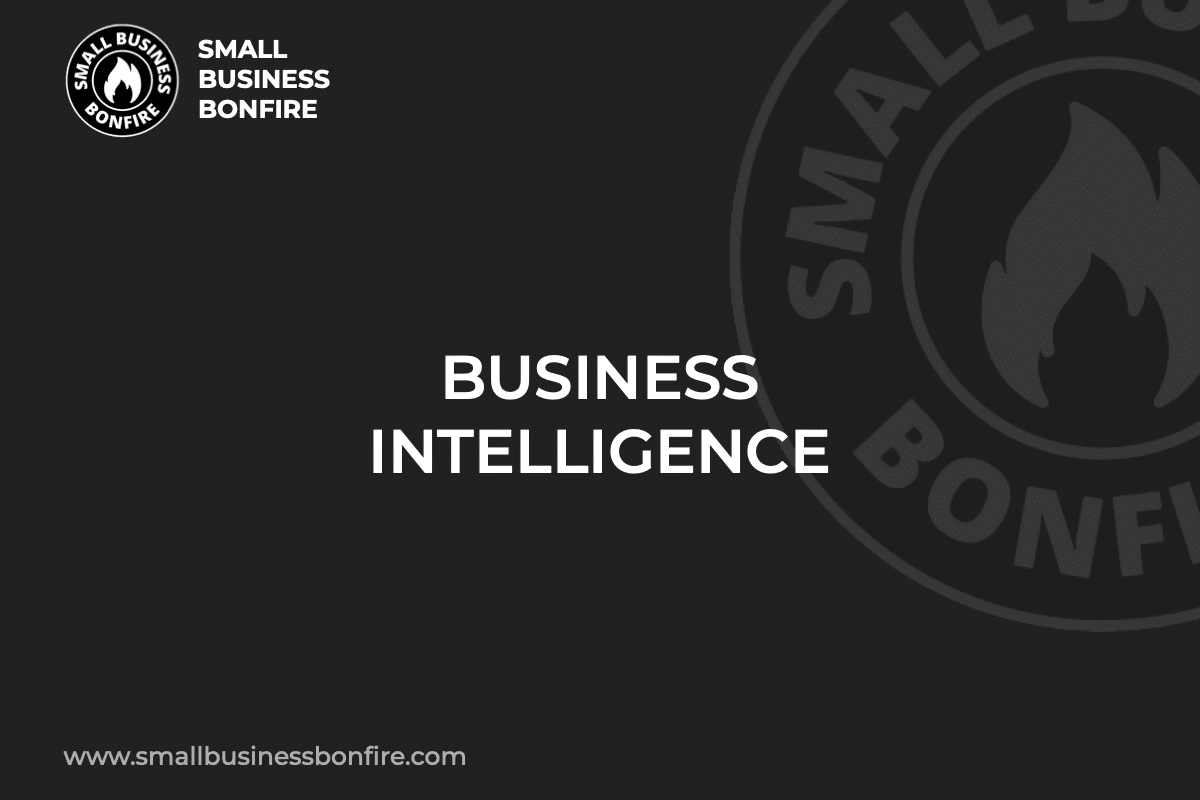Ever felt overwhelmed by the sheer volume of data your business generates?
In today’s digital age, data is being produced at an unprecedented rate. This massive influx of information can be incredibly challenging to manage, let alone analyze and use effectively.
Hi, my name is AJ! After building and selling my business for multiple seven figures, I started Small Business Bonfire.
Before my company scaled to success, my team and I wasted time, energy, and money trying to make the best decisions.
It was when I discovered business intelligence (BI) tools that operations really took off! Keep reading to learn more!
Key Takeaways
- Business intelligence systems use historical, customer, and time data to drive decisions.
- A BI tool can improve customer experiences and boost worker efficiency.
- Business intelligence technology provides data visualization.
- BI is critical because it improves decision-making and operational efficiency.
Related Reading: Best Small Business CRM
SBB Featured Partners
What is Business Intelligence (BI)?
Business intelligence is a technology-driven process for analyzing data and providing actionable insights.
Data mining is an essential aspect of business intelligence, as it involves extracting relevant patterns from large data sets, thereby enabling businesses to discover new insights and trends that might otherwise remain hidden.
As a result, executives, managers, and employees can make data-driven decisions instead of guessing the best direction.
The business intelligence process involves the following steps:
- Collecting data from internal IT systems
- Collecting raw data from external sources
- Preparing data for analysis
- Running queries against the data
- Creating data visualizations
When companies use BI, their primary goal is to make better business decisions that do the following things:
- Increase revenue
- Improve operational efficiency
- Gain a competitive edge of the competition
How does BI work? I’ll cover that in the following section!
How does Business Intelligence Work?
Business intelligence works somewhat like a super-smart detective.
Business intelligence tools collect clues (which are bits of data) about a company’s operations from different sources (like sales reports, customer feedback, or social media).
Then, with the help of special tools or software, it organizes these clues to make them easier to understand.
Different methods of organization can include the following visual representations:
- Graphs
- Pie charts
- Dashboards
The idea is to make it simpler to spot patterns, trends, or potential issues.
So, just like a detective uses clues to solve a case, a company can use business intelligence to make informed decisions to improve its business!
Using a customer relationship management (CRM) tool is a popular way companies use BI.
The CRM collects information on customer interactions, such as calls and purchases, to create an integrated view of the customer.
Why is Business Intelligence Important?
Business intelligence is crucial for a multitude of reasons.
However, the most prevalent reasons companies should use BI are:
- To improve decisions
- To improve operational efficiency
Let’s look at each of these aspects in closer detail.
Enhanced Decision Making
One of the primary reasons why business intelligence is essential is that it enhances decision-making processes.
By offering actionable insights derived from data analysis, BI tools empower businesses to make informed decisions.
Further, these decisions are based on raw data rather than assumptions or gut feelings.
Therefore, business intelligence tools significantly increase the chances of positive outcomes.
BI is a good choice for your business if making sales or marketing-related decisions terrifies you.
With BI, you’ll feel more confident about the direction you lead your team down!
Operational Efficiency
Business intelligence can dramatically improve operational efficiency within a company.
By identifying bottlenecks, inefficiencies, and wasteful practices in a company’s operations, BI tools allow businesses to streamline their processes.
When companies streamline their operations, it can lead to the following things:
- Cost savings
- Increased productivity
- A healthier bottom line
It’s crucial to know that you must continually improve business processes, even if you utilize BI recommendations.
Your company’s customer base, market, and product or service continually change, so your business processes should keep up with these shifts!
What is the Main Purpose of Business Intelligence?
The primary purpose of business intelligence is to use data analysis to make sure each business decision is thought out and driven by information rather than guesswork.
Business analytics provide companies with an array of information that can help improve aspects like:
- Marketing campaigns
- Sales strategies
- Sales pipeline stages
- Customer support techniques
Also, BI utilizes data visualization, making it easier for executives, managers, and employees to grasp business operations fully!
Benefits of Business Intelligence
Many advantages come when companies utilize business intelligence technologies.
Below, I’ve listed the most crucial benefits you must know!
Data-Driven Decision Making
Data-driven decision-making enables companies to make choices based on concrete, unbiased data instead of relying on intuition or observation.
This strategic approach not only increases the likelihood of achieving desired outcomes but also does the following things:
- Reduces risks
- Optimizes efficiency
- Promotes a deeper understanding of market trends and business performance
Faster Business Analysis
Business intelligence tools enable faster business analysis by automating the collection, integration, and organization of data from various sources.
Without specialized BI software, these manual processes would be time-consuming.
Further, business intelligence tools provide real-time insights and visual representations of data, allowing businesses to identify trends, patterns, and anomalies quickly.
Intuitive Dashboards
Business Intelligence presents data through intuitive dashboards.
These dashboards are graphical representations of a company’s key performance indicators (KPIs).
Further, these dashboards are customizable and interactive.
Therefore, individuals can monitor, analyze, and visualize various pieces of information at a glance.
Increased Organizational Efficiency
Business intelligence software increases organizational efficiency by identifying inefficiencies and bottlenecks within operational processes, illustrating areas of improvement.
Also, the automation of data collection and analysis saves significant amounts of time.
Therefore, BI frees up resources and allows personnel to focus on other critical areas of the organization.
Improved Customer Experience
BI can significantly enhance the customer experience by providing insights into the following things:
- Customer behavior
- Shopping and communication preferences
- Customer needs
- Pain points
Businesses can personalize their products, services, and communications through data analysis.
As a result, this fosters more substantial customer relationships and improves overall customer satisfaction.
Improved Employee Satisfaction
Another benefit of BI is that it leads to improved employee satisfaction by the following things:
- Streamlining workflows
- Eliminating inefficiencies
- Reducing the time-consuming tasks of data collection and analysis
Because BI handles business analytics, employees can focus on their core responsibilities and contribute to a more productive work environment.
Trusted Data Sources
Trusted data sources are a significant benefit of BI because they ensure the reliability and accuracy of the information utilized in decision-making processes.
By drawing from credible data sources, businesses can have confidence in the insights derived, leading to more secure and informed strategic decisions.
Increased Competitive Advantage
Business intelligence gives businesses a competitive edge by doing the following things:
- Delivering valuable insights derived from data analysis
- Enabling companies to anticipate market trends
- Understand customer behavior
- Optimize operational efficiency
Further, by facilitating data-driven decision-making, BI allows business users to strategically innovate, stay ahead of industry developments, and outmaneuver their competition!
Your competitors continually search for ways to improve and provide excellent customer experiences.
Therefore, you and your team must stay ahead of the curve! BI technology is the perfect way to stay ahead.
Business Intelligence Best Practices
Here are a few best practices associated with BI:
- Adopt a User-Centric Approach: Tailor the BI solution to the needs of its users, ensuring it’s intuitive and easy to understand.
- Ensure Data Quality: Maintaining the accuracy and reliability of your data sources is crucial.
- Promote a Data-Driven Culture: Encourage employees at all levels to incorporate data into their decision-making processes.
- Focus on Security: Protect your data assets by implementing robust security measures.
- Continually Evaluate and Adapt: BI is not a one-time solution but an ongoing process. Regularly review your objectives, measure the results, and adjust your strategies as necessary.
Business Intelligence Examples
Here are two real-life examples of companies analyzing data to improve business operations and customer experiences.
Example 1: Amazon – Personalized Recommendations
One example of BI in action is Amazon’s personalized recommendation system.
For instance, Amazon uses sophisticated algorithms to analyze customer behavior, including the following details:
- Purchase history
- Items in the cart
- Items rated and liked
- What other customers are buying
This data allows Amazon to provide highly personalized product recommendations in real time, enhancing the customer experience and driving more sales.
With personalized experiences, Amazon customers feel like the company is catering to them (which most shoppers prefer)!
Example 2: American Express – Predictive Analysis
American Express (AMEX) uses predictive analytics, a component of business intelligence, to analyze and interpret vast amounts of transaction data.
The intent is to identify patterns and trends to help make more informed decisions.
For instance, AMEX can predict customer loyalty by analyzing their spending patterns.
As a result, AMEX can provide personalized services and offers to retain their customers.
Business Intelligence vs. Business Analytics
While both business intelligence and business analytics are data-driven decision-making processes, their approach and purpose differ.
For example, BI uses software and services to turn data into actionable insights influencing business decisions.
BI primarily focuses on what’s happening now and what has happened in the past.
On the other hand, business analytics systematically explores an organization’s data, emphasizing statistical analysis.
Typically, BA tools are more predictive.
Further, BA aims to answer questions like:
- “Why is this happening?”
- “What if these trends continue?”
- “What will happen next?”
- “What is the best course of action?”
So, while BI helps to make sense of data, BA uses the data to predict and plan for the future.
History of Business Intelligence
Business intelligence dates back to the 19th century, but the term was first coined by Richard Millar Devens in 1865.
Yet, in the mid-20th century, Hans Peter Luhn, an IBM researcher, introduced BI as an automatic method to share information between different departments.
The technology and methodologies evolved rapidly with the advent of computers.
In the 1970s, businesses began to use decision-support systems.
The following years saw the emergence of data warehouses, online analytical processing (OLAP), and business intelligence analysts.
In the late 80s and early 90s, modern BI took shape as desktop computers became more prevalent and businesses started understanding the value of data-driven decision-making.
The 21st century brought advancements like:
- Big data analytics
- Cloud computing
- Mobile BI
- Machine learning
These tools revolutionized how businesses perceive and utilize data.
Today, BI tools can help businesses get actionable insights and strategic advantages in a competitive marketplace.
Types of Business Intelligence Tools
There are several power BI tools, so let’s see which are best for your company!
Ad Hoc Analysis
Ad hoc analysis writes and runs queries to analyze certain weak points in a business.
Typically, ad hoc analytics are incorporated into dashboards and reports.
Online Analytical Processing
Online Analytical Processing (OLAP) is a tool that allows users to analyze data from multiple dimensions, enabling the following things:
- Complex calculations
- Trend analyses
- Sophisticated data modeling
This feature is used to process high-level, aggregated data views.
Mobile BI
Mobile business intelligence is a cloud-based system that allows users to access data and insights from anywhere, anytime, using a mobile device.
Real-Time BI
Real-time BI is a modern approach that instantaneously delivers data analysis and reporting.
Real-time BI enables business users to decide things based on current data.
Operational Intelligence
Operational intelligence is a real-time dynamic business analytics category that delivers visibility and insight into data, streamlining business operations.
SaaS BI
Software as a Service (SaaS) BI is a cloud-based delivery model where business intelligence applications are hosted, managed by a service provider, and made available to customers over the internet on a subscription basis.
Open Source BI
Open Source BI are freely available BI tools that make source code public, enabling users to modify, distribute, and improve the software per their specific needs.
Embedded BI
Embedded BI is a set of tools integrated within business software, applications, or portals, enabling users to perform analytics within their usual workflows.
Also, embedded BI ensures companies don’t have to switch between applications.
Collaborative BI
Collaborative BI tool that combines the processes of data analysis with social media tools.
Further, these tools facilitate a seamless exchange of analytical results and decisions among team members within an organization.
Location Intelligence (LI)
Location intelligence (LI) is a traditional business intelligence tool that uses geographic data to gain insights into trends, patterns, and relationships within specific locations.
Business Intelligence for Big Data
Business intelligence and big data are intrinsically linked.
For instance, BI systems are often used to make sense of the enormous datasets that modern businesses accumulate.
Further, big data refers to the vast volumes of structured and unstructured data collected by organizations, including transaction records and social media posts.
On its own, big data is just a mass of information.
However, when analyzed through BI techniques, it can provide valuable insights to drive strategic decisions.
In other words, if big data is the raw material, BI is the process that refines it into a useful product.
Business Intelligence Trends
There have been several BI trends, especially as the technology continually improves.
One BI trend includes an increase in the number of BI specialists and positions.
For instance, BI teams can include the following people:
- BI managers
- BI developers
- BI architects
- BUI analysts
- BI specialists who work closely with data engineers
These individuals and other end users are part of the BI development process.
Another trend in BI is that businesses are shifting from traditional approaches to agile BI.
Agile BI breaks up BI tasks into smaller projects.
As a result, functionality improves, and employees are less likely to get overwhelmed.
Also, agile BI helps companies put BI features into use quicker and modify plans as soon as the business changes.
Additionally, trends in BI include the following things:
- Low-code and no-code development: More BI vendors are adding graphical tools that allow companies to develop applications with little or no coding.
- The proliferation of augmented analytics: BI capabilities are starting to use artificial intelligence to offer natural language querying and machine learning algorithms, helping companies work efficiently.
- Using the cloud more: BI solutions were slow at first. Now, cloud systems ensure business information is readily accessible regardless of where employees are.
- Improving data literacy: BI teams are continually improving the ways they transform raw data so users can understand it. Also, BI teams have created data literacy initiatives, ensuring users understand their data.
Closing Thoughts on Business Intelligence
Does your company need power BI software? It doesn’t hurt!
BI tools collect and organize information, offering several forms of data visualization to help users understand what’s happening in their business.
As a result, companies can make better decisions because they’re driven by in-depth data rather than guesswork!
How will your company use BI? Let us know in the comments section!
And good luck as you browse through business intelligence vendors!
Newsletter Signup
Join The Leads Field Guide Newsletter for tips, strategies and (free) resources for growing your leads, and closing more deals.




